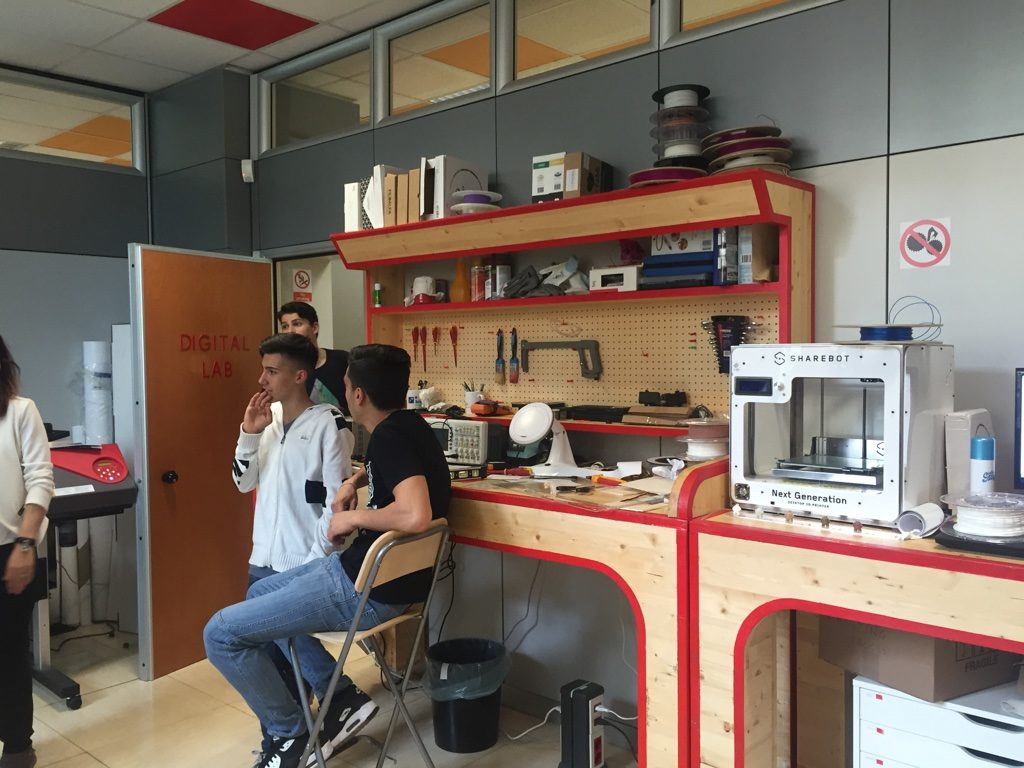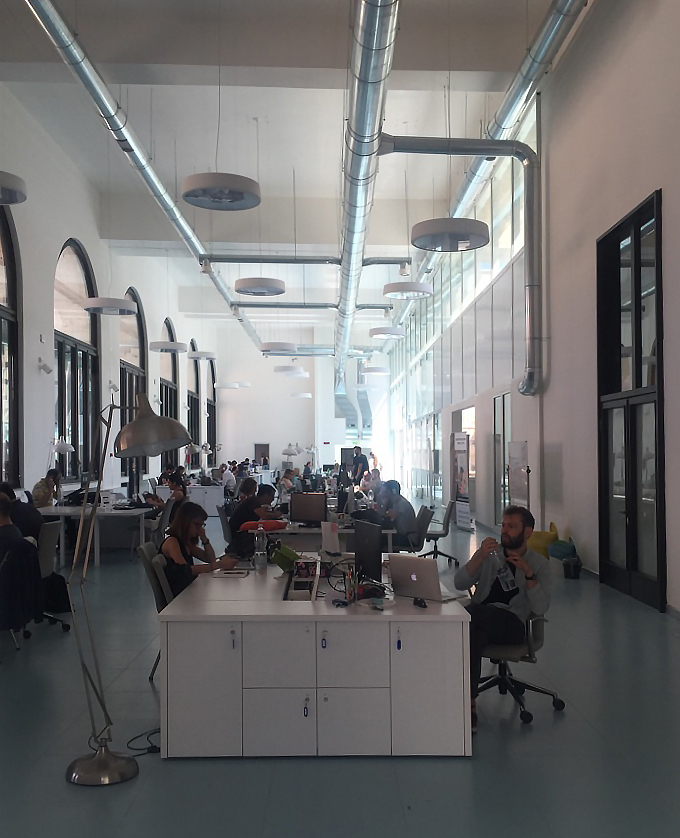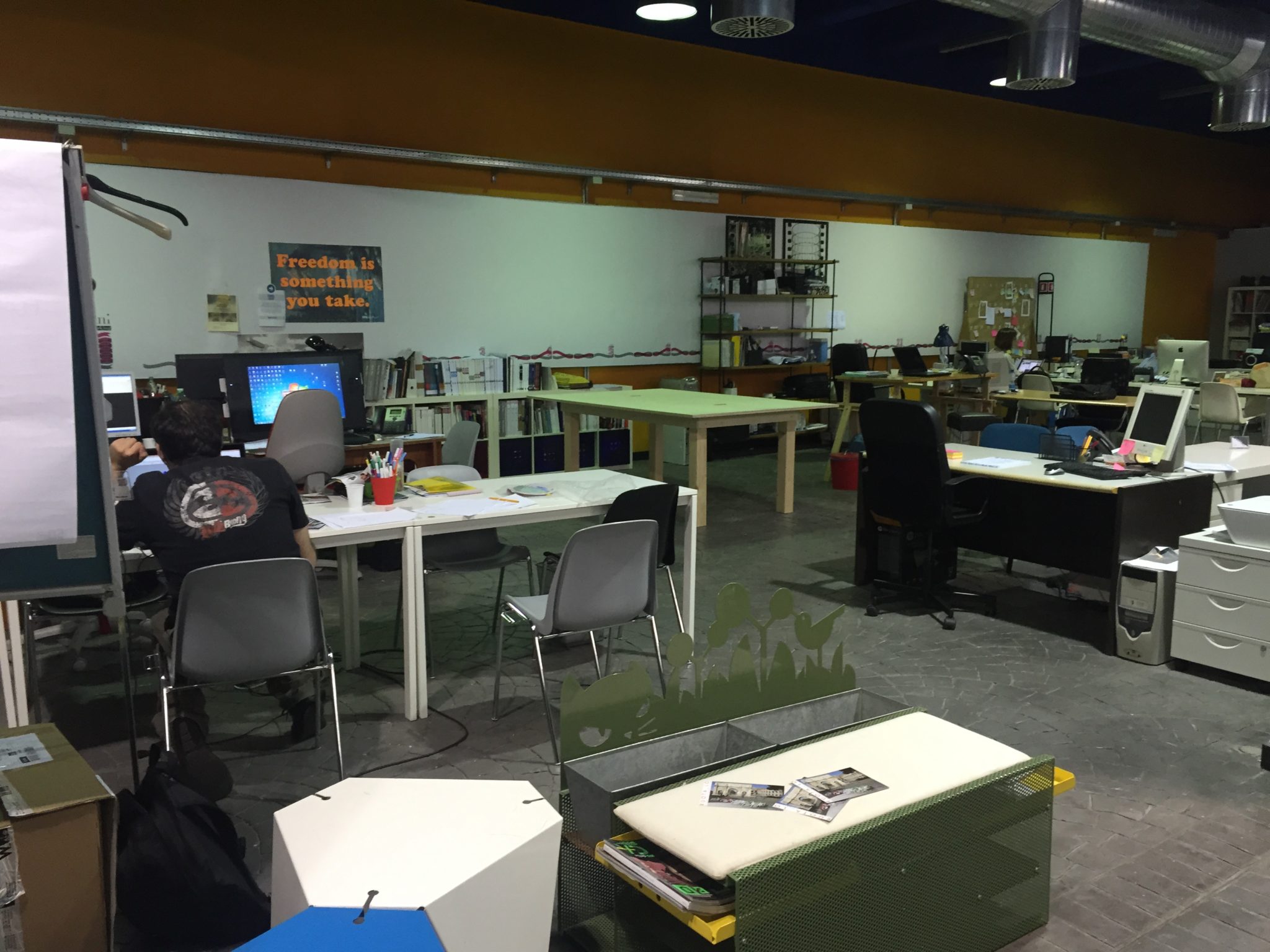Co-Working Spaces – A new agenda for place based economic development policies

DOI reference: 10.1080/13673882.2018.00001030
By Stefania Fiorentino, The Bartlett School of Planning, London’s Global University, UK
Drawing on evidence from a wider study of innovation dynamics in contemporary urban ecosystems, Stefania Fiorentino examines how the growing number of Co-Working Spaces (CWSs) in Rome reflect new patterns of local economic activity and development. Changes in the nature of work and the labour market – increasing job precarity and rising numbers of freelancers – have caused CWSs to become central to the channelling of funding opportunities for start-ups and knowledge spillovers. They therefore represent a necessary and as yet neglected focus for urban place based regeneration and economic policies.
Introduction
Increased political and economic uncertainties in Europe have affected the spatial distribution and workspace preferences of innovative small enterprises, which are now increasingly located in urban centres. Fuelled by a labour market dynamic of growing freelance and project-based work, flexible and shared office spaces have become a common solution to accommodate these new patterns of work.
In response to these trends and the 2008 financial crisis, there has been a renewed focus on entrepreneurs and urban areas amongst policy makers and experts in many fields e.g. economics, planning, sociology. In particular, policies targeting local and regional economic development have concentrated on creating tools for the support of small enterprises. The European Union has been instrumental in this process and has crafted a number of place based policies designed to support new entrepreneurial ventures as a way to re-instil economic growth in its member states (i.e. Smart Specialisation). Even Italy has delivered a number of measures specifically addressing start-ups which have focused on the settlement and funding of facilities and international events.
This article draws upon wider research on the geography of innovation in Rome, and discusses the role and the importance of CWSs in contemporary entrepreneurial ecosystems. The main goal of the project has been to understand these emerging entrepreneurial ecosystems and to develop policy frameworks to enhance and address the contribution of these facilities to urban economic development.
How do we understand co-working spaces?
Co-working spaces, have been presented as one of the key features of the ‘new’ urban economy. Populated by ‘makers’, or ‘digital artisans’, these facilities have acquired a varied nomenclature, referred to variously as: business incubators, business accelerators, fab labs, creative labs, etc. From an economic point of view, the emergence of these new entrepreneurial facilities, and the people who work in them, has been identified as the germ of a new industrial revolution, a revolution characterised by: creativity, technology, cross-sectorial knowledge, higher customisation opportunities, international linkages, local support; low initial capital costs and high risks (Anderson 2012; Birtchnell & Urry 2016).
These new spaces have been seen as an ideal environment in which to foster the sharing inclination of new small-scale enterprises (Schmidt & Brinks, 2017). That have themselves emerged was in response to a power dynamic between bottom-up processes of innovation stimulated by crisis necessities (cf. Bathelt and Boggs 2003), and top-down interventions aiming to promote a new wave of entrepreneurialism. This is reflected in the location of these enterprises and facilities, which tend to develop in spaces that allow them to benefit from the convergence of local institutional support (councils or other institutions providing spaces or commissioning services) and global channels of knowledge, online communities, and big networking events (cf. Bathelt & Turi 2011; Capdevila 2015). CWSs are therefore mostly an urban phenomenon as the diversity offered by inner city locations stands as a positive externality for this type of innovation (Duranton & Puga 2001). However, although the sociological implications of shared working spaces have been extensively researched (Brown, 2017; Merkel, 2015), their impact on local economic development dynamics have been only marginally considered.
Recent studies have discussed the role of these spaces in local economic development processes (Van Holm, 2017), and their relationship with entrepreneurs (Gertner & Mack, 2017). Research has also confirmed the impact of CWSs on education and employment creation (van Holm, 2015; Wang & Loo, 2017; Wolf-Powers et al., 2017), as well as the importance of entrepreneurial co-location within cities more generally (Andersson & Larsson, 2016; Witt, 2004). However, there is still a need in the current policy framework to specifically address the implications of these developments on economic and spatial planning. Most existing policies draw on exemplar cases of tech and creative cities (Landry, 2000; Porter, 2000), or technology driven clusters following the Silicon Valley model (Fiorentino, 2018; Martin & Sunley, 2003; Nathan, 2011). The policy focus on entrepreneurs has also generated a debate on the role that the public sector should (Mazzucato, 2013) or should not have (Mason, 2015) in enhancing innovation, which largely fails to mention the role of such spaces.
To understand the role of CWSs, it is helpful to take a step back and note that in recent years a new conception of innovation has developed, one which sees innovation occurring primarily at the scale of the Small and medium-sized enterprises (SME). Here, innovation is no longer a matter of ground-breaking technological discoveries, but instead consists of prototyping and testing new ways of integrating technology into existing craft techniques or services. Firms participating in these new urban entrepreneurial ecosystems of innovation and choosing to settle in CWSs are usually providing services to the leading local economic sector. In Rome, this is the public administration. Innovative firms are therefore grounded within the context of the city, despite their innovative features and the use of digital technologies. This embeddedness, together with the small size of the firms, suggests that place-based policies are still the best way to address this group of professionals and to manage the externalities produced by CWSs (c.f. Barca, McCann, & Rodríguez-Pose, 2012).
The study on Rome informing this article builds upon primary data generated from a set of 35 interviews with key actors from the innovation scene of the Italian capital city, including the local and regional administration of Lazio (the authority responsible for the allocation of funding, most of which stems from the EU to set-up institutionally-led incubators for start-ups and for the organization of dedicated events (cf. Schmidt et al. 2017)). The sample also included a number of intermediary actors that emerged through the course of the research. These actors were generally new professional figures managing businesses in the ecosystem, or institutionally created roles designed to facilitate the process of cluster creation. The sample also included a large number of managers and users of CWSs.

Rome as a case study
Since 2012, there has been a period of increased focus in Italy on start-ups as a means to address economic stagnation and crisis. As discussed, this focus was partly determined by policy directives and pressure from the EU. These influences resulted in a twofold strategy:
At the national scale; the Ministry of Economic Development (MiSE) set out the following interventions to tackle economic growth and enhance employment rates:
- The creation of a business registry of innovative start-ups and subsequently of innovative SME and certified incubators held by the Chamber of Commerce, which granted fiscal benefits to the subscribers (Law n. 221 of the 17th of December 2012).
- The establishment of a system of micro financing opportunities, Fondo di Garanzia, which granted funds for new entrepreneurial ventures, either as a spin-off of existing firms, or specifically for start-ups, whether they subscribed to the above register or not (updated in 2012 by the Decree Law “Salva Italia” promulgated by MiSE).
At the regional scale, regions dealt with these two main lines of intervention by creating sets of similar policies. In addition, regions also had to comply with EU guidelines and incentives (e.g. cf. Programma Operativo Regionale FESR 2014 – 2020).
Something that became apparent in this research project, in the specific case of the Lazio region, was that most of its R&D expenditure coming from EU sources, was redirected into four policy areas:
- Micro-finance allocation
- Provision of venues to host publicly managed CWSs
- Provision of enabling services, such as training, educational support, or acceleration and incubation programs
- Organization of dedicated events and fairs e.g. the Maker Faire
Interventions at the local scale of the municipal authority, Comune di Roma, and the borough level, municipi, also exist, but tended to overlap with the above list. At this scale, the venues granted for CWSs were managed by private associations or firms, with modest or sometimes no support from the local authority, resulting in a series of initiatives that were fragmented and not systematically regulated.
The way these spaces were implemented largely relied on informality. In Rome, there are currently no planning regulations for the development, settlement or management of CWSs and their related neighbourhoods. Both regional and local municipal authorities at the borough level authorized the creation of, or managed, several co-working spaces hosting training, acceleration and incubation programs along with other events dedicated to start-ups or makers. This has led to the creation of an incredible array of different CWSs displaying different levels of engagement and ties to the surrounding socio-economic context.
In the literature, there is a general perception that a self-organizing approach is the best way to create innovative processes. However, as these spaces develop within an existing urban fabric, it becomes obvious that real estate market trends, the availability of premises and the accessibility of infrastructures and amenities, as well as the urban history of the various neighbourhoods, all contribute to the clustering of these activities. The distribution of innovative entrepreneurial activities and events within cities is therefore the result of a mix of top-down and bottom-up processes. In a fragmented and complex geography like that of the city of Rome, global professional networks and local institutional ties tend to converge in intermediate places such as CWSs. In this context, CWSs act as more than just affordable solutions for freelances and low initial capital businesses (cf. Ferm 2014); they also allow on a smaller scale the knowledge spillovers generated in bigger agglomerations of firms acting like temporary clusters, fairs and international events (cf. Ramírez-Pasillas 2008; Power & Jansson 2008). Aside from being interesting urban phenomena (cf. Spinuzzi 2015), they therefore also play a central role in the explanation of recent economic, urban and social transformations that most developed countries are experiencing.
With the exception of real estate developments, which show little real engagement with processes of economic development, other than exploiting a new trend, there are two types of CWSs observed in Rome that act as intermediaries of innovation. The first type are bottom-up and focused on social entrepreneurship and the educational implication of the new digital technologies. The second, are those connected to venture capitalists or major state-led companies and therefore operate in closer alignment to the corporate world (Keuschnigg & Nielsen, 2004; cf. Schmidt & Brinks, 2017). Both these types of CWS reinforce the linkages between formal opportunities created by regional institutions and professionals, in a way that recalls the role trade associations or unions used to have in the traditional Fordist economy.
Towards place-based policies for Co-Working Spaces and Small and Medium-Sized Enterprises
Despite the spontaneous bottom up nature of this first type of CWS and the lack of any formal planning, my research revealed a relatively consistent pattern to the spatial distribution of these types of CWSs. They were located primarily with an aim to reviving historic traditions and craft ateliers in former productive sites. This was linked to a number of factors: creation of enabling amenities, affordable real estate prices, availability of decaying venues in need of a new purpose, sufficient access to transport and infrastructure, and most significantly, the openness of local authorities and business institutions. Local authorities were particularly motivated to engage in these developments in order to resolve longstanding issues of socio-economic development.
Interviews with municipal officers highlighted that CWSs aided local development and kick-started regeneration processes with significant effects on the surrounding neighbourhood, suggesting that the formal recognition of such workspaces in planning policies could serve as a tool to address issues of inequality and urban decay. This lack of regulation at the local and regional level was lamented by the managers and users of these facilities. Single initiatives were seen to be isolated and there was felt to be a lack of coordination between different branches of the local authority. In addition, professionals lamented the slowness of the public funding allocation system, which lagged in spaces designed to connect SME to the larger and quicker provisions of private venture capitals.
CWSs provide an informative context in which economic development and spatial planning become increasingly intertwined. Crafting measures for their support therefore requires a multi-disciplinary approach and a significant update to policies that target both urban regeneration and economic development. In Italy, planning operates as a prescriptive system orientated towards controlling urbanization, and the example of CWSs suggests the need for a more strategic view focused on regeneration and conservation: A system that would integrate old and new urban fabrics and regulate the evolution and resilience of the city, rather than just its physical expansion.
To achieve this, local councils should ideally be granted greater regulatory powers. In the case of CWSs, a general framework for the procurement of CWS managers should be crafted at the national or urban scale, but with each tender being assessed at the local scale to take into account the needs of each neighbourhood. Public-private partnerships in the allocation of premises to be turned into CWSs should also be structured in the form of tailored “social” leases. A capped rent would be paid to the local authority in exchange for social services and the provision of activities or amenities assessed according to the local needs: as seen in Rome these facilities can range from creches to virtual reality rooms. The same applies to events and training opportunities that can be organised in the space. In this way services could be tailored to the needs of local areas, creating a win-win in which all stakeholders benefit.
Among the risks associated with regulation of CWSs is gentrification. This is true especially if these spaces are thought of as real estate entities and products; however the formal creation of a system of capped leases and contextualized bids for the allocation of public spaces to be dedicated to CWSs will mitigate those negative effects, enhancing instead their positive externalities in terms of jobs creation in different economic sectors. Overall the assessment of local resources – either missing or to be enhanced – to be included in a mid-term place-based policy framework should also correspond at the regional level to the key principles behind the EU Smart Specialization Strategy.

Conclusion
The example of Rome highlights the crucial role of public-private partnerships for the establishment and management of CWSs and the positive effects these facilities can have in areas struggling with the long-term socio-economic effects of the 2008 recession. Recognising and including CWSs in the development of future place-based policies for economic development indicates a potential new direction for such policies, based on tools and systems designed to re-organize urban planning around new trends in the economy and labour market. Building on this understanding could also be the first step towards greater integration between ‘planning for regeneration’ and ‘economic for innovation’ strategies.
One concrete proposal to achieve these goals would be to formalise the public-private partnerships that underpin the success of CWSs. At present these agreements are mostly informal, however interviews with key stakeholders in both the public and private sector confirmed that the inclusion of such spaces among the offer of local facilities partnered by the local authorities would be perceived as a positive measure. Policies such as these could weaken the hegemony of large multinationals over economic development by connecting various small scale sectors of the economy and promoting sustainable forms of planned growth. This would however require urban and regional planning, at least in the Italian context, to become more multi-disciplinary and to refocus itself on restructuring existing urban systems, rather than controlling the development of new ones. In other words, planning needs to be even more locally informed, developing strategic partnerships and collaborations with the private sector that deliver long-term, local socio-economic development within existing urban fabrics.
Although this research has focused on Rome, it is likely that similar policies could also be relevant in other contexts where opportunities for locally planned and integrated CWSs offering affordable rates need creating. For instance, in London, freelancers and SME suffer from a similar shortage of dedicated office spaces due to the entry of major multinational players into the flexible office space market, such as WeWork, and thus removing most of the affordable CWSs options for SME.
To move to this kind of strategic and integrated approach, however, there is a need for a broader debate across society: What economic goals do we want to reach? How can we build a city-brand attracting investments according to such goals? How can we connect the different economic sectors and stakeholders in an integrated strategy for an urban area? How do we respond to increasing rates of freelancing and flexible work? Most of those challenges have not yet been addressed by current policies targeting innovation, economic development or even urban regeneration, and in the current climate, threatened by austerity, economic crisis and political uncertainties, it is crucial for planning governance to respond to those arising challenges. Open for future research is the quantitative assessment of the outcomes of these measures and of the economic performances of the professionals benefiting from them.

References
Anderson, C. (2012). Makers. The New Industrial Revolution. London: the Random House Group ltd.
Andersson, M., & Larsson, J. P. (2016). Local entrepreneurship clusters in cities. Journal of Economic Geography, 16(1), 39–66.
Barca, F., McCann, P., & Rodríguez-Pose, A. (2012). The case for regional development intervention: place-based versus place-neutral approaches. Journal of Regional Science, 52(1), 134–152.
Capdevila, I. (2015). Co-working Spaces and the Localized Dynamics of Innovation in Barcelona. International Journal of Innovation Management, 19(3). article.
Dougherty, D. (2012). The Maker Movement. Innovations, 7(3), 11–14.
Fiorentino, S. (2018). Re-making urban economic geography. Start-ups, entrepreneurial support and the Makers Movement: A critical assessment of policy mobility in Rome. Geoforum, 93, 116–119.
Gertner, D., & Mack, E. (2017). The Entrepreneurial Orientation (EO) of Incubators, Accelerators, and Co-working Spaces. International Journal of Regional Development, 4(2), 1.
Keuschnigg, C., & Nielsen, S. B. (2004). Start-ups, venture capitalists, and the capital gains tax. Journal of Public Economics, 88(5), 1011–1042.
Landry, C. (2000). The Creative City. A Toolkit for Urban Innovators. London: Earthscan.
Martin, R., & Sunley, P. (2003). Deconstructing clusters: chaotic concept or policy panacea? Journal of Economic Geography, 3, 5–35. Journal Article.
Mason, P. (2015). Postcapitalism: a guide to our future. Penguin Random House UK.
Mazzucato, M. (2013). The entrepreneurial state : debunking public vs. private sector myths. London and New York: Anthem Press.
Nathan, M. (2011). East London Tech City : Ideas without a strategy ? Local Economy, 26(3), 197–202.
Porter, M. E. (2000). Location, Competition, and Economic Development: Local Clusters in a Global Economy. Economic Development Quarterly, 14(1), 15–34.
Schmidt, S., & Brinks, V. (2017). Open creative labs: Spatial settings at the intersection of communities and organizations. Creativity and Innovation Management, 26(3), 291–299.
van Holm, E. J. (2015). Makerspaces and Contributions to Entrepreneurship. Procedia – Social and Behavioral Sciences, 195, 24–31.
Van Holm, E. J. (2017). Makerspaces and Local Economic Development. Economic Development Quarterly, 31(2), 164–173.
Wang, B., & Loo, B. P. Y. (2017). Hubs of Internet Entrepreneurs: The Emergence of Co-working Offices in Shanghai, China. Journal of Urban Technology, 24(3), 67–84.
Whitley, R. (2006). Project-based firms: New organizational form or variations on a theme? Industrial and Corporate Change, 15(1), 77–99.
Witt, P. (2004). Entrepreneurs’ networks and the success of start-ups. Entrepreneurship and Regional Development, 16(5), 391–412.
Wolf-Powers, L., Doussard, M., Schrock, G., Heying, C., Eisenburger, M., & Marotta, S. (2017). The Maker Movement and Urban Economic Development. Journal of the American Planning Association, 83(4), 365–376.
About the author
Stefania Fiorentino is a researcher at The Bartlett School of Planning (UCL), UK. Her research interests cover different fields including planning, real estate and economic geography, reflecting her cross sectorial background and her interests in the contemporary socio-economic dynamics of cities and implications for local/regional economic development.
